最新双宾语用法回顾整理
- 格式:pdf
- 大小:5.66 KB
- 文档页数:2
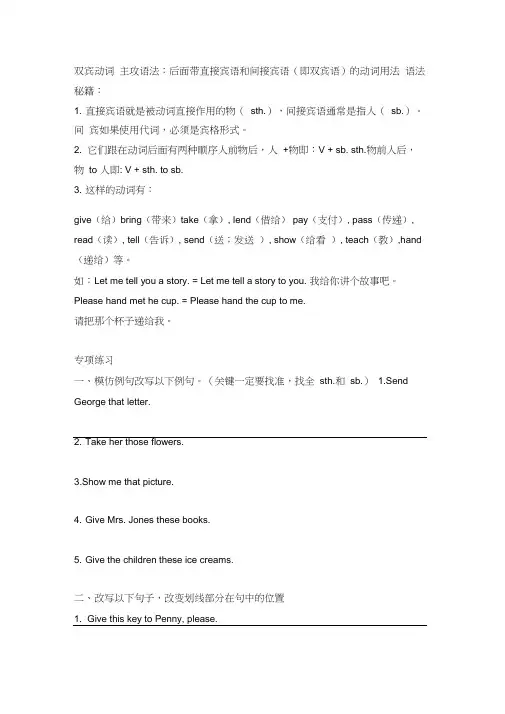
双宾动词主攻语法:后面带直接宾语和间接宾语(即双宾语)的动词用法语法秘籍:1. 直接宾语就是被动词直接作用的物(sth.),间接宾语通常是指人(sb.)。
间宾如果使用代词,必须是宾格形式。
2. 它们跟在动词后面有两种顺序人前物后,人+物即:V + sb. sth.物前人后,物to 人即: V + sth. to sb.3. 这样的动词有:give(给)bring(带来)take(拿), lend(借给) pay(支付), pass(传递), read(读), tell(告诉), send(送;发送), show(给看), teach(教),hand (递给)等。
如:Let me tell you a story. = Let me tell a story to you. 我给你讲个故事吧。
Please hand met he cup. = Please hand the cup to me.请把那个杯子递给我。
专项练习一、模仿例句改写以下例句。
(关键一定要找准,找全sth.和sb.) 1.Send George that letter.2. Take her those flowers.3.Show me that picture.4. Give Mrs. Jones these books.5. Give the children these ice creams.二、改写以下句子,改变划线部分在句中的位置1. Give this key to Penny, please.2. Don' t give that one to him.3. Send these flowers to her.4. Don' t show your homework to Sam.5. Bring these magazines to Sally.6. Hand the hammer to your father.7. Don' t send these tickets to them.8. Can you lend an English book to me?9. Pass the ball to her, please.10. Tell the truth to me.三、汉译英。
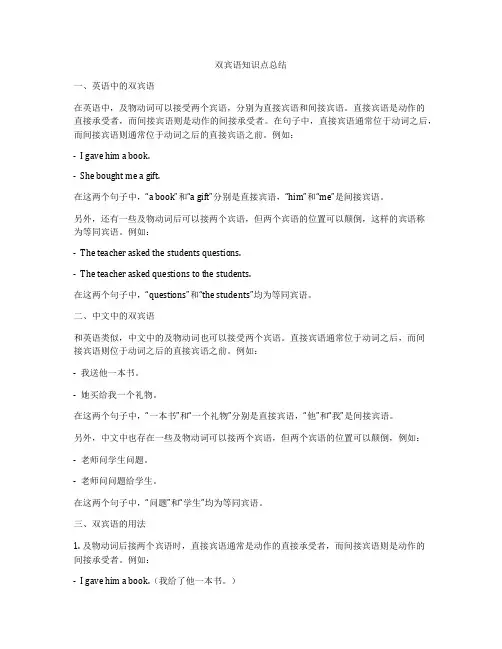
双宾语知识点总结一、英语中的双宾语在英语中,及物动词可以接受两个宾语,分别为直接宾语和间接宾语。
直接宾语是动作的直接承受者,而间接宾语则是动作的间接承受者。
在句子中,直接宾语通常位于动词之后,而间接宾语则通常位于动词之后的直接宾语之前。
例如:- I gave him a book.- She bought me a gift.在这两个句子中,“a book”和“a gift”分别是直接宾语,“him”和“me”是间接宾语。
另外,还有一些及物动词后可以接两个宾语,但两个宾语的位置可以颠倒,这样的宾语称为等同宾语。
例如:- The teacher asked the students questions.- The teacher asked questions to the students.在这两个句子中,“questions”和“the students”均为等同宾语。
二、中文中的双宾语和英语类似,中文中的及物动词也可以接受两个宾语。
直接宾语通常位于动词之后,而间接宾语则位于动词之后的直接宾语之前。
例如:- 我送他一本书。
- 她买给我一个礼物。
在这两个句子中,“一本书”和“一个礼物”分别是直接宾语,“他”和“我”是间接宾语。
另外,中文中也存在一些及物动词可以接两个宾语,但两个宾语的位置可以颠倒,例如:- 老师问学生问题。
- 老师问问题给学生。
在这两个句子中,“问题”和“学生”均为等同宾语。
三、双宾语的用法1. 及物动词后接两个宾语时,直接宾语通常是动作的直接承受者,而间接宾语则是动作的间接承受者。
例如:- I gave him a book.(我给了他一本书。
)在这个句子中,“a book”是直接宾语,表示给出的物品,“him”是间接宾语,表示接收物品的人。
2. 及物动词后可以接两个宾语,但两个宾语的位置可以颠倒,这样的宾语称为等同宾语。
例如:- The teacher asked the students questions.(老师问学生问题。
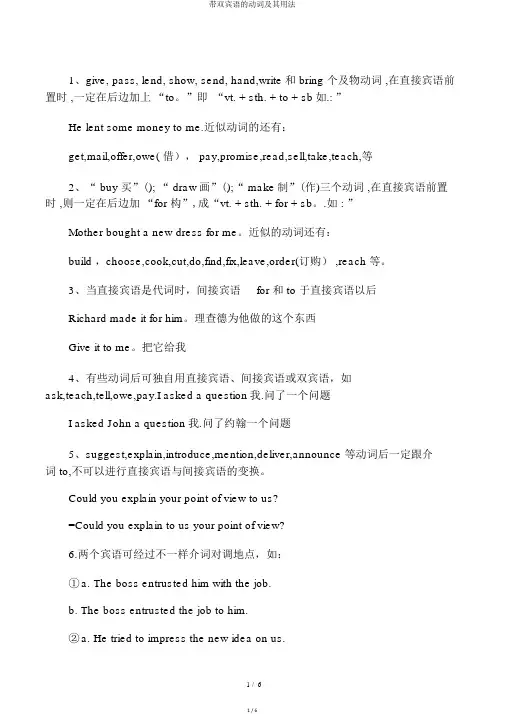
1、give, pass, lend, show, send, hand,write和 bring 个及物动词 ,在直接宾语前置时 ,一定在后边加上“to。
”即“vt. + sth. + to + sb如.:”He lent some money to me.近似动词的还有:get,mail,offer,owe( 借), pay,promise,read,sell,take,teach,等2、“ buy 买”(); “ draw画”();“ make制”(作)三个动词 ,在直接宾语前置时 ,则一定在后边加“for 构”,成“vt. + sth. + for + sb。
.如 : ”Mother bought a new dress for me。
近似的动词还有:build ,choose,cook,cut,do,find,fix,leave,order(订购) ,reach 等。
3、当直接宾语是代词时,间接宾语for 和 to 于直接宾语以后Richard made it for him。
理查德为他做的这个东西Give it to me。
把它给我4、有些动词后可独自用直接宾语、间接宾语或双宾语,如ask,teach,tell,owe,pay.I asked a question我.问了一个问题I asked John a question我.问了约翰一个问题5、suggest,explain,introduce,mention,deliver,announce 等动词后一定跟介词to,不可以进行直接宾语与间接宾语的变换。
Could you explain your point of view to us?=Could you explain to us your point of view?6.两个宾语可经过不一样介词对调地点,如:①a. The boss entrusted him with the job.b. The boss entrusted the job to him.②a. He tried to impress the new idea on us.b. He tried to impress us with the new idea.③a. A general should inspire his soldiers with great courage.b. A general should inspire great courage in his soldiers.7.不一样介词,不一样意思,如:④a. Who introduced John to you?b. Who introduced John into the new office?⑤a. We warned him of the hazard.b. We warned him against the hazard.(a.指存在的危险; b.指可能的危险)(a.指同类人或物对照; b.指两样不一样东西相互比较)⑦ a. Helen was disappointed of the prize.b. Helen was disappointed in the prize.(a.指没得奖而绝望; b.指对所得的奖不满而绝望)⑧a. The cake is allied to the flour.b. Is Taiwan allied with America?( a.指两样东西相关系; b.指两个国家有结盟关系)8.两个宾语与介词各就各位,固定不变,如:⑨The police cautioned the tourists of the danger ahead.(警惕)⑩ Can a doctor cure June of her chronic illness?(医治)●No one can deprive a citizen of his human right(.剥夺)9.以返身代词为宾语的习用语,如:●I hope you will avail yourself of the golden opportunity(.利用)●My friends often pride themselves on their rare achievements(.以骄傲)●Jill knows how to insinuate herself into her boss's favour(.向献媚取宠)●We look down on those ingrating themselves with their superiors.(讨好)10、几个固定搭配的带双宾语的动词正确的说法:rob sb of sthsteal sb from sth.近似的还有:cure sb of illness治愈某人疾病rid sb of sth 从----中除掉(不好的东西)supply sb with sth 供应某人某物provide sb with sth 给某人供应某物accuse sb of sth指控某人某事cheat sb of sth 欺骗某人某物inform / advise sb of sth 通知某人某事remind sb of sth 是某人想起某事warn sb of sth 警示某人某状况charge sb with sth 谴责某人某事answer 回答bring 带buy 买do 做get 拿give 给hand 递keep 守旧leave 留下lend 借make 做offer 供应owe 欠pass 传promise 承诺read 读save 省下sell 卖send 寄show 看sing 唱take 拿teach 教tell 说wish 希望write 写costdenyenvyrefusePlease answer me the question请.回答我的问题Bring me the book.把书递给我Father bought me an ice cream.爸爸给我买了一个冰淇淋。
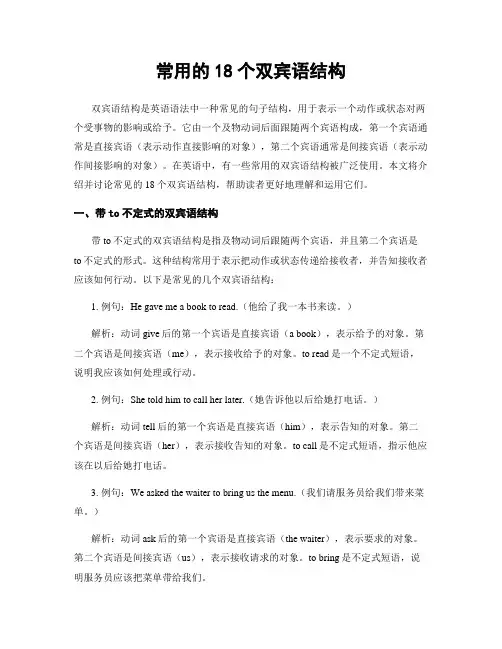
常用的18个双宾语结构双宾语结构是英语语法中一种常见的句子结构,用于表示一个动作或状态对两个受事物的影响或给予。
它由一个及物动词后面跟随两个宾语构成,第一个宾语通常是直接宾语(表示动作直接影响的对象),第二个宾语通常是间接宾语(表示动作间接影响的对象)。
在英语中,有一些常用的双宾语结构被广泛使用。
本文将介绍并讨论常见的18个双宾语结构,帮助读者更好地理解和运用它们。
一、带to不定式的双宾语结构带to不定式的双宾语结构是指及物动词后跟随两个宾语,并且第二个宾语是to不定式的形式。
这种结构常用于表示把动作或状态传递给接收者,并告知接收者应该如何行动。
以下是常见的几个双宾语结构:1. 例句:He gave me a book to read.(他给了我一本书来读。
)解析:动词give后的第一个宾语是直接宾语(a book),表示给予的对象。
第二个宾语是间接宾语(me),表示接收给予的对象。
to read是一个不定式短语,说明我应该如何处理或行动。
2. 例句:She told him to call her later.(她告诉他以后给她打电话。
)解析:动词tell后的第一个宾语是直接宾语(him),表示告知的对象。
第二个宾语是间接宾语(her),表示接收告知的对象。
to call是不定式短语,指示他应该在以后给她打电话。
3. 例句:We asked the waiter to bring us the menu.(我们请服务员给我们带来菜单。
)解析:动词ask后的第一个宾语是直接宾语(the waiter),表示要求的对象。
第二个宾语是间接宾语(us),表示接收请求的对象。
to bring是不定式短语,说明服务员应该把菜单带给我们。
4. 例句:They hired a guide to show them around the city.(他们雇了一个导游向他们展示城市。
)解析:动词hire后的第一个宾语是直接宾语(a guide),表示雇佣的对象。
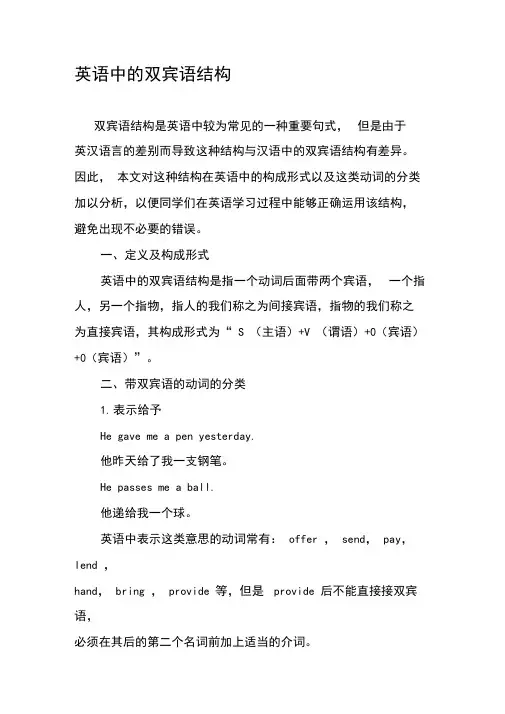
英语中的双宾语结构双宾语结构是英语中较为常见的一种重要句式,但是由于英汉语言的差别而导致这种结构与汉语中的双宾语结构有差异。
因此,本文对这种结构在英语中的构成形式以及这类动词的分类加以分析,以便同学们在英语学习过程中能够正确运用该结构,避免出现不必要的错误。
一、定义及构成形式英语中的双宾语结构是指一个动词后面带两个宾语,一个指人,另一个指物,指人的我们称之为间接宾语,指物的我们称之为直接宾语,其构成形式为“ S (主语)+V (谓语)+0(宾语)+0(宾语)”。
二、带双宾语的动词的分类1.表示给予He gave me a pen yesterday.他昨天给了我一支钢笔。
He passes me a ball.他递给我一个球。
英语中表示这类意思的动词常有:offer ,send,pay,lend ,hand,bring ,provide 等,但是provide 后不能直接接双宾语,必须在其后的第二个名词前加上适当的介词。
2.表示取得I borrowed Tom 1 ,000 yuan.我借了汤姆 1 000 块钱。
Please fetch me my textbook.请把我的课本拿来。
英语里这类动词还有:find ,get,save,earn,take ,gain等。
3.表示制作My mum made me a big cake.我的妈妈给我做了一个大蛋糕。
My mum often cook me delicious food.我的妈妈经常给我做美味的食物。
英语里这类动词还有:sing ,bake,play ,draw,build 等。
4.表示交流、交谈May I ask you some questions ?我可以问你一些问题吗?The little girl showed me her beautiful dress.那个小女孩给我展示了她漂亮的连衣裙。
在英语中这类动词还有:teach ,tell ,read ,write ,telephone 等。
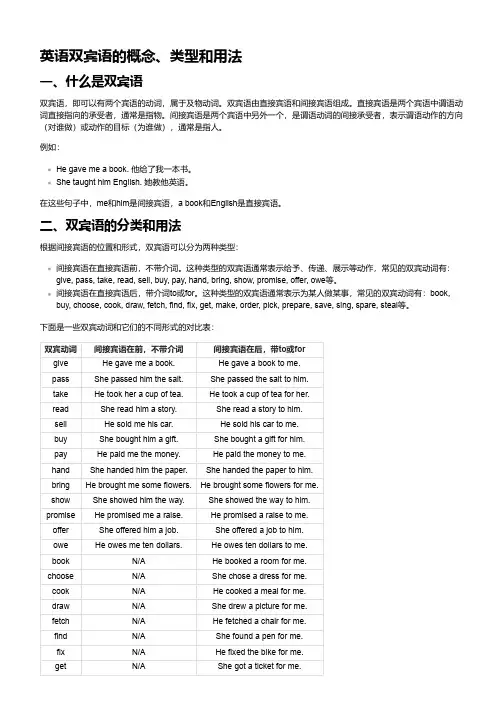
英语双宾语的概念、类型和用法一、什么是双宾语双宾语,即可以有两个宾语的动词,属于及物动词。
双宾语由直接宾语和间接宾语组成。
直接宾语是两个宾语中谓语动词直接指向的承受者,通常是指物。
间接宾语是两个宾语中另外一个,是谓语动词的间接承受者,表示谓语动作的方向(对谁做)或动作的目标(为谁做),通常是指人。
例如:He gave me a book. 他给了我一本书。
She taught him English. 她教他英语。
在这些句子中,me和him是间接宾语,a book和English是直接宾语。
二、双宾语的分类和用法根据间接宾语的位置和形式,双宾语可以分为两种类型:间接宾语在直接宾语前,不带介词。
这种类型的双宾语通常表示给予、传递、展示等动作,常见的双宾动词有:give, pass, take, read, sell, buy, pay, hand, bring, show, promise, offer, owe等。
间接宾语在直接宾语后,带介词to或for。
这种类型的双宾语通常表示为某人做某事,常见的双宾动词有:book, buy, choose, cook, draw, fetch, find, fix, get, make, order, pick, prepare, save, sing, spare, steal等。
下面是一些双宾动词和它们的不同形式的对比表:双宾动词间接宾语在前,不带介词间接宾语在后,带to或forgive He gave me a book.He gave a book to me.pass She passed him the salt.She passed the salt to him.take He took her a cup of tea.He took a cup of tea for her.read She read him a story.She read a story to him.sell He sold me his car.He sold his car to me.buy She bought him a gift.She bought a gift for him.pay He paid me the money.He paid the money to me.hand She handed him the paper.She handed the paper to him.bring He brought me some flowers.He brought some flowers for me.show She showed him the way.She showed the way to him.promise He promised me a raise.He promised a raise to me.offer She offered him a job.She offered a job to him.owe He owes me ten dollars.He owes ten dollars to me.book N/A He booked a room for me.choose N/A She chose a dress for me.cook N/A He cooked a meal for me.draw N/A She drew a picture for me.fetch N/A He fetched a chair for me.find N/A She found a pen for me.fix N/A He fixed the bike for me.get N/A She got a ticket for me.双宾动词间接宾语在前,不带介词间接宾语在后,带to或formake N/A He made a cake for me.order N/A She ordered a pizza for me.pick N/A He picked a flower for me.prepare N/A She prepared a speech for me.save N/A He saved a seat for me.sing N/A She sang a song for me.spare N/A He spared some time for me.steal N/A She stole a kiss from me.三、双宾语的变化规则在使用双宾语时,需要注意以下几个变化规则:当直接宾语是人称代词(it/them),间接宾语是名词时,或两个宾语都是人称代词时,通常要用介词to或for引起的短语。
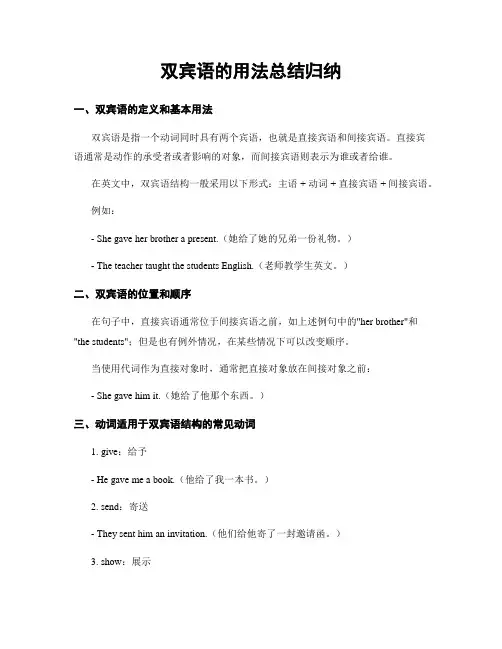
双宾语的用法总结归纳一、双宾语的定义和基本用法双宾语是指一个动词同时具有两个宾语,也就是直接宾语和间接宾语。
直接宾语通常是动作的承受者或者影响的对象,而间接宾语则表示为谁或者给谁。
在英文中,双宾语结构一般采用以下形式:主语 + 动词 + 直接宾语 + 间接宾语。
例如:- She gave her brother a present.(她给了她的兄弟一份礼物。
)- The teacher taught the students English.(老师教学生英文。
)二、双宾语的位置和顺序在句子中,直接宾语通常位于间接宾语之前,如上述例句中的"her brother"和"the students";但是也有例外情况,在某些情况下可以改变顺序。
当使用代词作为直接对象时,通常把直接对象放在间接对象之前:- She gave him it.(她给了他那个东西。
)三、动词适用于双宾语结构的常见动词1. give:给予- He gave me a book.(他给了我一本书。
)2. send:寄送- They sent him an invitation.(他们给他寄了一封邀请函。
)3. show:展示- She showed her friends some pictures.(她给她的朋友们展示了一些图片。
)4. tell:告诉- He told me a secret.(他告诉了我一个秘密。
)5. teach:教- The professor taught the students a new theory.(教授教了学生们一个新理论。
)注意,以上动词也可以使用其他结构,如带有介词的宾语等。
四、双宾语和介词短语的搭配有时候,在交流中为了更准确地表达意思,双宾语还可以与介词短语一起使用。
例如:- She gave a present to her brother.(她给了她的兄弟一份礼物。
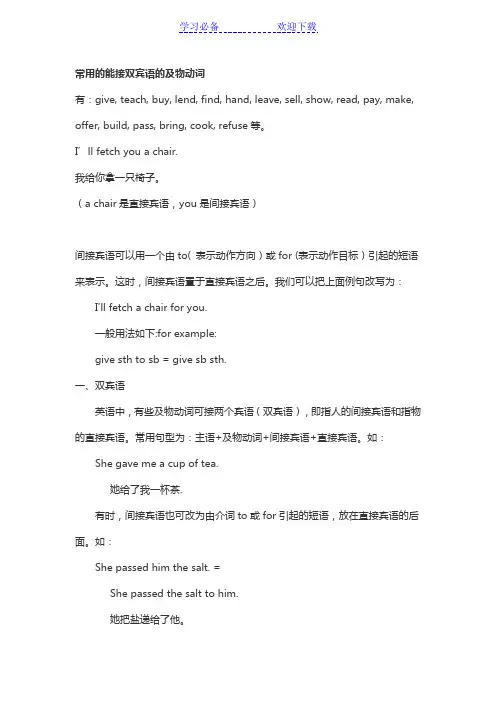
常用的能接双宾语的及物动词有:give, teach, buy, lend, find, hand, leave, sell, show, read, pay, make, offer, build, pass, bring, cook, refuse等。
I’ll fetch you a chair.我给你拿一只椅子。
(a chair是直接宾语,you是间接宾语)间接宾语可以用一个由to( 表示动作方向)或for (表示动作目标)引起的短语来表示。
这时,间接宾语置于直接宾语之后。
我们可以把上面例句改写为:I'll fetch a chair for you.一般用法如下:for example:give sth to sb = give sb sth.一、双宾语英语中,有些及物动词可接两个宾语(双宾语),即指人的间接宾语和指物的直接宾语。
常用句型为:主语+及物动词+间接宾语+直接宾语。
如:She gave me a cup of tea.她给了我一杯茶.有时,间接宾语也可改为由介词to或for引起的短语,放在直接宾语的后面。
如:She passed him the salt. =She passed the salt to him.她把盐递给了他。
Her uncle bought her an English-Chinese dictionary yesterday. = Her uncle bought an English-Chinese dictionary for her yesterday.昨天,她叔叔给她买了一本英汉词典。
双宾语的特殊情况下面几种情况,通常要用介词to或for引起的短语:1. 当直接宾语是人称代词(it/them),间接宾语是名词时:或两个宾语都是人称代词时。
如:The watch is Li Lei's. Please give it to him.这块手表是李雷的。
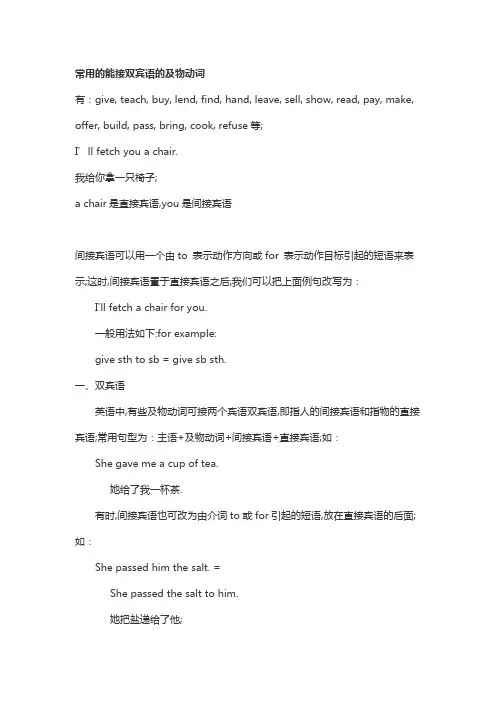
常用的能接双宾语的及物动词有:give, teach, buy, lend, find, hand, leave, sell, show, read, pay, make, offer, build, pass, bring, cook, refuse等;I’ll fetch you a chair.我给你拿一只椅子;a chair是直接宾语,you是间接宾语间接宾语可以用一个由to 表示动作方向或for 表示动作目标引起的短语来表示;这时,间接宾语置于直接宾语之后;我们可以把上面例句改写为:I'll fetch a chair for you.一般用法如下:for example:give sth to sb = give sb sth.一、双宾语英语中,有些及物动词可接两个宾语双宾语,即指人的间接宾语和指物的直接宾语;常用句型为:主语+及物动词+间接宾语+直接宾语;如:She gave me a cup of tea.她给了我一杯茶.有时,间接宾语也可改为由介词to或for引起的短语,放在直接宾语的后面;如:She passed him the salt. =She passed the salt to him.她把盐递给了他;Her uncle bought her an English-Chinese dictionary yesterday. = Her uncle bought an English-Chinese dictionary for her yesterday.昨天,她叔叔给她买了一本英汉词典;双宾语的特殊情况下面几种情况,通常要用介词to或for引起的短语:1. 当直接宾语是人称代词it/them,间接宾语是名词时:或两个宾语都是人称代词时;如:The watch is Li Lei's. Please give it to him.这块手表是的;请把它给他;2. 当强调间接宾语时;如:Mother cooks breakfast for us every day.母亲每天都为我们做早饭;3. 当间接宾语比直接宾语长时;如:On the bus, he often gives his seat to an old person.在公共汽车上,他经常把座位让给老人;注:由to连接间接宾语的动词有:pass, give, show, tell, lend, take等;由for 连接间接宾语的动词有:buy, cook, get, sing, make等;award sb. sth. = award sth. to sb. 颁奖给某人bring sb. sth. = bring sth. to sb. 把某物带给某人hand sb. sth. =hand sth. to sb. 把某物递给某人lend sb. sth. = lend sth. to sb. 把某物借给某人mail sb. sth. = mail sth. to sb. 把某物寄给某人offer sb. sth. = offer sth. to sb. 将某物给某人owe sb. sth. = owe sth. to sb. 欠某人某物pass sb. sth. = pass sth. to sb. 把某物递给某人pay sb. sth. = pay sth. to sb. 付给某人某物钱post sb. sth. = post sth. to sb. 把某物寄给某人read sb. sth. = read sth. to sb. 把某物读给某人听return . = return sth. to sb. 把某物还给某人send sb. sth. = send sth. to sb. 把某物送给某人sell sb. sth. = sell sth. to sb. 把某物卖给某人serve sb. sth. = serve sth. to sb. 拿某物招待某人show sb. sth. = show sth. to sb. 拿某物给某人看take sb. sth. = take sth. to sb. 把某物拿给某人teach sb. sth. = teach sth. to sb. 教某人某物tell sb. sth. = tell sth. to sb. 告诉某人某情况throw sb. sth. = throw sth. to sb. 把某物扔给某人write sb. sth. = write sth. to sb. 给某人写信book sb. sth. = book sth. for sb. 为某人预定某物buy sb. sth. = buy sth. for sb. 为某人买某物choose sb. sth. = choose sth. for sb. 为某人选某物cook sb. sth. = cook sth. for sb. 为某人煮某物draw sb. sth. = draw sth. for sb. 为某人画某物fetch sb. sth. = fetch sth. for sb. 为某人去取某物find sb. sth. = find sth. for sb. 为某人找到某物fix sb. sth. = fix sth. for sb. 为某人准备某物get sb. sth. = get sth. for sb. 为某人拿来某物make sb. sth. = make sth. for sb. 为某人做某物order sb. sth. = order sth. for sb. 为某人订购某物pick sb. sth. = pick sth. for sb. 为某人采摘某物prepare sb. sth. = prepare sth. for sb. 为某人准备某物save sb. sth. = save sth. for sb. 为某人留某物sing sb. sth. = sing sth. for sb. 为某人唱某物歌spare sb. sth. = spare sth. for sb. 为某人让出某物steal sb. sth. = steal sth. for sb. 为某人偷某物三有的动词后接的双宾语易位时,既可用介词to引出间接宾语,也可用介词for引出间接宾语,含义相同;如bring,play等:Bring me today’s paper.= Bring today’s paper to for me. 把今天的报纸拿给我;2. He played us the record he had just bought.= He played the record he had just bought for to us. 他放了他刚买的唱片给我们听;四有的动词后接的双宾语易位时,即可用介词to引出间接宾语,也可用介词for引出间接宾语,含义不同;如leave等:They left me no food.= They left no food for me.他们没给我留一点食物;2. My uncle left me a large fortune.= My uncle left a large fortune to me. 叔叔死后留下一大笔财产给我;五而有的动词后接双宾语时,既不能用介词to引出间接宾语,也不能用介词for引出间接宾语;如allow, ask, cause, charge, cost, forgive, refuse等:He allows his son too much money.他给他儿子的钱太多;He asked me some questions. 他问了我一些问题;This caused me much trouble. 这给我带来了许多麻烦;He charged me five dollars for a cup of tea.他一杯茶向我要了5美元;His mistake cost him his job. 他的错误让他丢了工作;I envy you your good luck. 我羡慕你的好运;They forgave him his rudeness. 他们原谅了他的鲁莽;He refused her nothing. 她要什么他就给什么;。
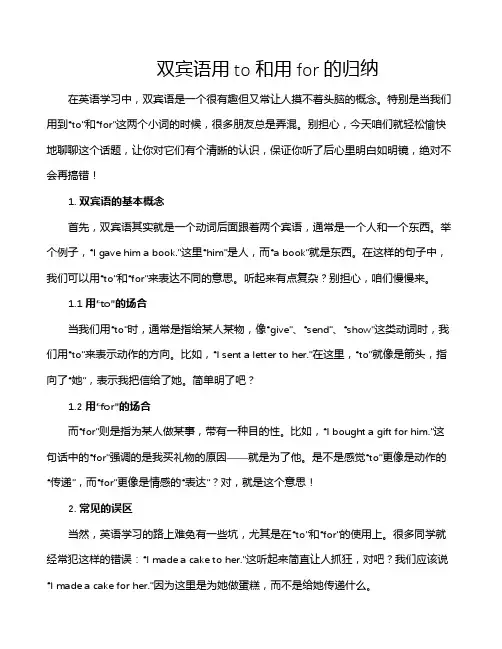
双宾语用to和用for的归纳在英语学习中,双宾语是一个很有趣但又常让人摸不着头脑的概念。
特别是当我们用到“to”和“for”这两个小词的时候,很多朋友总是弄混。
别担心,今天咱们就轻松愉快地聊聊这个话题,让你对它们有个清晰的认识,保证你听了后心里明白如明镜,绝对不会再搞错!1. 双宾语的基本概念首先,双宾语其实就是一个动词后面跟着两个宾语,通常是一个人和一个东西。
举个例子,“I gave him a book.”这里“him”是人,而“a book”就是东西。
在这样的句子中,我们可以用“to”和“for”来表达不同的意思。
听起来有点复杂?别担心,咱们慢慢来。
1.1 用“to”的场合当我们用“to”时,通常是指给某人某物,像“give”、“send”、“show”这类动词时,我们用“to”来表示动作的方向。
比如,“I sent a letter to her.”在这里,“to”就像是箭头,指向了“她”,表示我把信给了她。
简单明了吧?1.2 用“for”的场合而“for”则是指为某人做某事,带有一种目的性。
比如,“I bought a gift for him.”这句话中的“for”强调的是我买礼物的原因——就是为了他。
是不是感觉“to”更像是动作的“传递”,而“for”更像是情感的“表达”?对,就是这个意思!2. 常见的误区当然,英语学习的路上难免有一些坑,尤其是在“to”和“for”的使用上。
很多同学就经常犯这样的错误:“I made a cake to her.”这听起来简直让人抓狂,对吧?我们应该说“I made a cake for her.”因为这里是为她做蛋糕,而不是给她传递什么。
2.1 理解语境要想搞明白用“to”还是“for”,最关键的就是理解语境。
你可以问自己:我是在给某人某物吗?还是为某人做了什么呢?这时候,你的脑袋里就会出现一个小小的分界线,帮助你轻松做出选择。
2.2 习惯积累另外,多读、多听也是必不可少的。
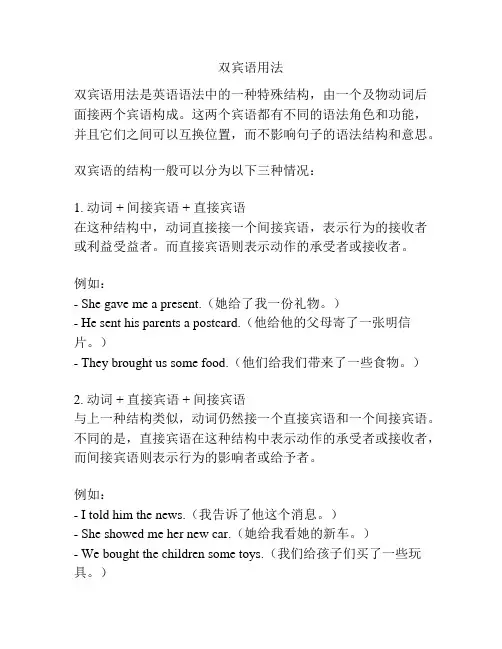
双宾语用法双宾语用法是英语语法中的一种特殊结构,由一个及物动词后面接两个宾语构成。
这两个宾语都有不同的语法角色和功能,并且它们之间可以互换位置,而不影响句子的语法结构和意思。
双宾语的结构一般可以分为以下三种情况:1. 动词 + 间接宾语 + 直接宾语在这种结构中,动词直接接一个间接宾语,表示行为的接收者或利益受益者。
而直接宾语则表示动作的承受者或接收者。
例如:- She gave me a present.(她给了我一份礼物。
)- He sent his parents a postcard.(他给他的父母寄了一张明信片。
)- They brought us some food.(他们给我们带来了一些食物。
)2. 动词 + 直接宾语 + 间接宾语与上一种结构类似,动词仍然接一个直接宾语和一个间接宾语。
不同的是,直接宾语在这种结构中表示动作的承受者或接收者,而间接宾语则表示行为的影响者或给予者。
例如:- I told him the news.(我告诉了他这个消息。
)- She showed me her new car.(她给我看她的新车。
)- We bought the children some toys.(我们给孩子们买了一些玩具。
)3. 动词 + 直接宾语 + 间接宾语 + 宾语补足语在这种结构中,动词接收一个直接宾语、一个间接宾语,以及一个宾语补足语。
直接宾语表示动作的承受者或接收者,间接宾语表示行为的影响者或给予者,宾语补足语则对直接宾语进行进一步的说明或补充。
例如:- We made him the team captain.(我们任命他为队长。
)- They elected her the president.(他们选举她为总统。
)- I consider it my duty to help.(我认为帮助是我的责任。
)在双宾语句子中,有时候间接宾语可以被动词转换为介词短语,并放在句子的末尾。
1、give, pass, lend, show, send, hand,write和bring 个及物动词,在直接宾语前置时,必须在后面加上“to”;即“vt. + sth. + to + sb.” 如:He lent some money to me.类似动词的还有:get,mail,offer,owe借,pay,promise,read,sell,take,teach,等2、“buy”买;“draw”画;“make”制作三个动词,在直接宾语前置时,则必须在后边加“for”,构成“vt. + sth. + for + sb.”;如:Mother bought a new dress for me;类似的动词还有:build,choose,cook,cut,do,find,fix,leave,order订购,reach等;3、当直接宾语是代词时,间接宾语for和to于直接宾语之后Richard made it for him;理查德为他做的这个东西Give it to me;把它给我4、有些动词后可单独用直接宾语、间接宾语或双宾语,如ask,teach,tell,owe,pay.I asked a question. 我问了一个问题I asked John a question.我问了约翰一个问题5、suggest,explain,introduce,mention,deliver,announce等动词后必须跟介词to,不能进行直接宾语与间接宾语的转换;Could you explain your point of view to us=Could you explain to us your point of view6.两个宾语可通过不同介词对换位置,如:①a. The boss entrusted him with the job. b. The boss entrusted the job to him.②a. He tried to impress the new idea on us. b. He tried to impress us with the new idea.③a. A general should inspire his soldiers with great courage. b. A general should inspire great courage in his soldiers.7.不同介词,不同意思,如:④a. Who introduced John to you b. Who introduced John into the new office⑤a. We warned him of the hazard. b. We warned him against the hazard.a. 指存在的危险;b. 指可能的危险⑥a. When compared with each other, there are differences between the twins.b. We may compare the heart to a pump. a. 指同类人或物对比;b.指两样不同东西互相比拟⑦a. Helen was disappointed of the prize. b. Helen was disappointed in the prize. a. 指没得奖而失望;b. 指对所得的奖不满而失望⑧a. The cake is allied to the flour.b. Is Taiwan allied with America a.指两样东西有关联;b. 指两个国家有联盟关系8.两个宾语与介词各就各位,固定不变,如:⑨The police cautioned the tourists of the danger ahead.警惕⑩Can a doctor cure June of her chronic illness医治● The company has to compensate its staff for their losses.弥补● No one can deprive a citizen of his human right.剥夺9.以返身代词为宾语的惯用语,如:● I hope you will avail yourself of the golden opportunity. 利用● My friends often pride themselves on their rare achie vements.以……自豪● Jill knows how to insinuate herself into her boss's favour.向……献媚取宠● We look down on those ingratiating themselves with their superiors.讨好……10、几个固定搭配的带双宾语的动词正确的说法:rob sb of sth steal sb from sth.类似的还有:cure sb of illness 治愈某人疾病rid sb of sth 从----中除去不好的东西supply sb with sth 供给某人某物provide sb with sth 给某人提供某物accuse sb of sth 控告某人某事cheat sb of sth 骗取某人某物inform / advise sb of sth 通知某人某事remind sb of sth 是某人想起某事warn sb of sth 警告某人某情况charge sb with sth 指责某人某事answer 回答Please answer me the question. 请回答我的问题bring 带Bring me the book.把书递给我buy 买Father bought me an ice cream. 爸爸给我买了一个冰淇淋; do 做Could you do it for me 你能帮我做这事吗get 拿Get me a cup of tea.给我拿杯茶;give 给The teacher gave me some advice. 老师给了我一些建议; hand 递Hand me the hammer. 把榔头给我keep 保守Can you keep a secret for me你能为我保守秘密吗leave 留下Some one left you this note. 有人给你留下这张条子; lend 借She lent me her bike. 她把自行车借给了我;make 做My mother made me a coat. 妈妈为我做了一件衣服;offer 提供I offered him a glass of wine. 我敬了她一杯酒;owe 欠Sandy owed Judy one dollar. Sandy 欠了Judy一美元; pass 传Pass me the newspaper. 把报纸传给我;promise 承诺He promised me a book. 他给了我一本书;read 读Please read me the letter. 请帮我读一读这封信;save 省下That will save us a lot of trouble. 那将省去我们许多麻烦;I sold my brother my car for 300 pounds.我以300磅把车卖sell 卖给了弟弟;I’ll send grandma a gift on her birthday. 祖母生日时我寄给send 寄她一份礼物;show 看Show your ticket, please. 请出示你得票子;sing 唱Will you sing us a song 你能为我们唱一首歌吗The work took us a week on finish.这工作花去我们一个星期take 拿的时间;teach 教She teaches me French. 她教我们法语;tell 说I told her my name. 我告诉她我的名字wish 但愿I wish you a happy New Year.新年快乐;write 写Sue is writing her mother a letter 她正在给她妈妈写信; costdenyenvyrefuse。
——可接双宾语的常用动词(1) 双宾语易位时需借助介词to的常用动词award sb. sth. = award sth. to sb.颁奖给某人bring sb. sth. = bring sth. to sb.把某物带给某人hand sb. sth. =hand sth. to sb.把某物递给某人lend sb. sth. = lend sth. to sb.把某物借给某人mail sb. sth. = mail sth. to sb.把某物寄给某人offer sb. sth. = offer sth. to sb.将某物给某人owe sb. sth. = owe sth. to sb.欠某人某物pass sb. sth. = pass sth. to sb.把某物递给某人pay sb. sth. = pay sth. to sb.付给某人某物(钱)post sb. sth. = post sth. to sb.把某物寄给某人read sb. sth. = read sth. to sb.把某物读给某人听return sb. sth. = return sth. to sb.把某物还给某人send sb. sth. = send sth. to sb.把某物送给某人sell sb. sth. = sell sth. to sb.把某物卖给某人serve sb. sth. = serve sth. to sb.拿某物招待某人show sb. sth. = show sth. to sb.拿某物给某人看take sb. sth. = take sth. to sb.把某物拿给某人teach sb. sth. = teach sth. to sb.教某人某物tell sb. sth. = tell sth. to sb.告诉某人某情况throw sb. sth. = throw sth. to sb.把某物扔给某人write sb. sth. = write sth. to sb.给某人写信(2) 双宾语易位时需借助介词for的常用动词book sb. sth. = book sth. for sb.为某人预定某物buy sb. sth. = buy sth. for sb.为某人买某物choose sb. sth. = choose sth. for sb.为某人选某物cook sb. sth. = cook sth. for sb.为某人煮某物draw sb. sth. = draw sth. for sb.为某人画某物fetch sb. sth. = fetch sth. for sb.为某人去取某物find sb. sth. = find sth. for sb.为某人找到某物fix sb. sth. = fix sth. for sb.为某人准备某物get sb. sth. = get sth. for sb.为某人拿来某物make sb. sth. = make sth. for sb.为某人做某物order sb. sth. = order sth. for sb.为某人订购某物pick sb. sth. = pick sth. for sb.为某人采摘某物prepare sb. sth. = prepare sth. forsb. 为某人准备某物save sth. = save sth. for sb.为某人留某物sing sb. sth. = sing sth. for sb.为某人唱某物(歌)spare sb. sth. = spare sth. for sb.为某人让出某物steal sb. sth. = steal sth. for sb.为某人偷某物有的动词后接的双宾语易位时,既可用介词to引出间接宾语,也可用介词for引出间接宾语,含义相同如:bring,playBring me today’s paper. = Bring today’s paper to [for] me.把今天的报纸拿给我。
双宾语的用法复合宾语的综述双宾语由直接宾语和间接宾语组成。
那双宾语要怎么使用呢?以下是由店铺整理关于双宾语的用法的内容,希望大家喜欢!双宾语的用法什么时候出现双宾语e.g.: They gave him a watch.这里的him 是间接宾语, a watch 是直接宾语, 这种间接宾语和直接宾语同时出现的情况叫双宾语间接宾语前to和for的用法I showed the map to Ben =I showed Ben the map.必背动词bring give hand leave lend offer pass pay play promise sell send show sing take tellget book build buy bake fetch find keep knit make order常用的能接双宾语的及物动词有:give, teach, buy, lend, find, hand, leave, sell, show, read, pay, make, offer, build, pass, bring, cook,refuse等。
I’ll fetch you a chair.我给你拿一只椅子。
(a chair是直接宾语,you是间接宾语)间接宾语可以用一个由to( 表示动作方向)或for (表示动作目标)引起的短语来表示。
这时,间接宾语置于直接宾语之后。
我们可以把上面例句改写为:I'll fetch a chair for you.一般用法如下:for example:give sth to sb = give sb sth.一、双宾语英语中,有些及物动词可接两个宾语(双宾语),即指人的间接宾语和指物的直接宾语。
常用句型为:主语+及物动词+间接宾语+直接宾语。
如:She gave me a cup of tea. 她给了我一杯茶。
有时,间接宾语也可改为由介词to或for引起的短语,放在直接宾语的后面。
双宾语了解双宾语的结构和用法双宾语:了解双宾语的结构和用法双宾语是英语语法中的一种特殊结构,它指一句话中同时出现两个宾语,即直接宾语和间接宾语。
直接宾语(direct object)是动作的承受者,而间接宾语(indirect object)则是动作的受益者或者是所(给)的人。
双宾语结构在句子中通常出现在及物动词后面,用于进一步补充或者说明动作的对象和受益者。
本文将详细介绍双宾语的结构和用法。
一、双宾语的基本结构在句子中,双宾语通常以及物动词为前提,其结构基本为:给定对象(间接宾语)+动作+实际对象(直接宾语)。
下面通过一些例句来具体说明。
1. Please pass me the book.请把书递给我。
在这个例句中,给定对象是"me"(间接宾语),实际对象是"the book"(直接宾语),动作是"pass"。
注意,动词"pass"同时有一个间接宾语和一个直接宾语,因此形成了双宾语结构。
2. My mom bought me a new phone.我妈妈给我买了一部新手机。
这个例句中,给定对象是"me"(间接宾语),实际对象是"a new phone"(直接宾语),动作是"bought"。
同样地,动词"bought"同时有一个间接宾语和一个直接宾语,形成了双宾语结构。
需要注意的是,当句子中出现了双宾语结构时,可以使用代词来代替宾语,这可以使句子更加简洁明了。
比如,在上述例句中,可以将"the book"换成宾格代词"it",将"a new phone"换成宾格代词"it",即"Please pass me it."和"My mom bought me it."。
双宾语语法总结范文双宾语语法是指一个动词同时可以接受两个宾语的情况。
一般来说,一个动词只能接受一个宾语,但在一些情况下,这种规则可以被打破。
双宾语语法在英语中非常常见,掌握双宾语语法对于理解和使用英语非常重要。
以下是关于双宾语语法的总结。
一、双宾语的定义双宾语是指在一个句子中同时出现的两个宾语,一个是间接宾语(indirect object),另一个是直接宾语(direct object)。
间接宾语表示动作的目标或者受益人,而直接宾语则直接接受动作。
例如,在句子"I gave my friend a book."中,"my friend"是间接宾语,"a book"是直接宾语。
动词"gave"表示动作,间接宾语"my friend"表示动作的目标或受益人,直接宾语"a book"则是动作的对象。
二、动词的选择并不是所有的动词都可以接受双宾语,只有一些特定的动词才能满足这个语法结构。
一些常见的可以接受双宾语的动词包括give, offer, send, tell, show等。
例如,"I bought her a present."中的动词"bought"可以接受双宾语,而"her"是间接宾语,"a present"是直接宾语。
三、双宾语的位置在句子中,双宾语一般出现在动词之后。
间接宾语通常放在直接宾语之前,但在一些情况下它们的位置可以交换。
例如,在句子"Please give me the book."中,间接宾语"me"位于直接宾语"the book"之前。
四、代词的使用在使用双宾语时,可以使用代词来替代宾语,这样可以避免重复使用名词。
在这种情况下,间接宾语使用代词"to",而直接宾语使用代词"it"或者"them"。
双宾动词主攻语法:后面带直接宾语和间接宾语(即双宾语)的动词用法语法秘籍:1.直接宾语就是被动词直接作用的物(sth.),间接宾语通常是指人(sb.)。
间宾如果使用代词,必须是宾格形式。
2. 它们跟在动词后面有两种顺序人前物后,人+物即:V + sb. sth.物前人后,物to 人即: V + sth. to sb.3.这样的动词有:give(给)bring(带来)take(拿), lend(借给) pay(支付), pass(传递), read(读), tell(告诉), send(送;发送), show(给看), teach(教),hand(递给)等。
如:Let me tell you a story. = Let me tell a story to you. 我给你讲个故事吧。
Please hand met he cup. = Please hand the cup to me.请把那个杯子递给我。
专项练习一、模仿例句改写以下例句。
(关键一定要找准,找全sth.和sb.)1.Send George that letter.___________________________________________________2.Take her those flowers.____________________________________________________3.Show me that picture._____________________________________________________4.Give Mrs. Jones these books._____________________________________________________5.Give the children these ice creams._____________________________________________________二、改写以下句子,改变划线部分在句中的位置。
双宾语用法回顾
英语中,有些及物动词可以接两个宾语,即指人的间接宾语和指物的直接宾语,这两个宾语合称为“双宾语”。
学习和使用双宾语时应注意以下要点:
1. 有些动词接双宾语,若间接宾语位于直接宾语之后时,其前必须使用介词to。
常见的这类动词有bring, give, hand, lend, offer, owe, pass, sell, send, show, tell, return, write等。
如:
Thank you for offering me your umbrella.
= Thank you for offering your umbrella to me.
We still owe the company $500.
= We still owe $500 to the company.
She wrote me a letter once a month.
= She wrote a letter to me once a month.
2. 有些动词接双宾语,若间接宾语位于直接宾语之后时,其前必须使用介词for。
常见的这类动词有build, buy, cook, fetch, find, get, order, paint, fix, save, sing, spare等。
如:
His aunt bought him a CD player on his birthday.
= His aunt bought a CD player for him on his birthday.
He sat down by the window and ordered himself a coffee.
= He sat down by the window and ordered a coffee for himself.
注意:如果直接宾语是人称代词,一般只能置于间接宾语之前。
如:
That pen is mine. Please return it to me. (不能说成Please return me it)
I left my keys in the office. Will you fetch them for me? (不能说成Will you fetch me them?)
3. 有些动词后的间接宾语不能改为由to或for引起的短语,常见的这类动词有allow, ask, charge, cost, envy, forgive, kiss, promise, refuse, wish等。
如:
Wish you good luck! (不能说成Wish good luck to / for you)
The dress cost me exactly $100. (不能说成The dress cost $100 to / for me.)
They allowed me only a few minutes to prepare. (不能说成allow sth. to / for sb.)
4. 有些动词接双宾语时,间接宾语前总是要加上介词to。
常见的这类动词有
announce, explain, express, introduce, report, suggest, describe, complain, mention 等。
如:
Will you explain the poem to me once again? (不能说成explain sb. sth.)
The headmaster introduced to us the famous scientist. (句中的to不能省略)
The girl reported to the policeman what she had seen in the street. (
不能说成report sb. sth.)
5. 能够充当直接宾语的除了名词和代词以外,还可以是“疑问词+ 动词不定式”结构或宾语从句。
如:
The teacher told them what to do next.
She asked me how I was getting on with my new job.
Please remind him that the meeting has been put off till next week.
6. 带双宾语结构的句子在变为被动语态时,通常有两种情况。
如:
She showed me a photo of her family.
→I was shown a photo of her family.或A photo of her family was shown to me.
He gave the little girl an apple.
→The little girl was given an apple.或An apple was given to the little girl.。